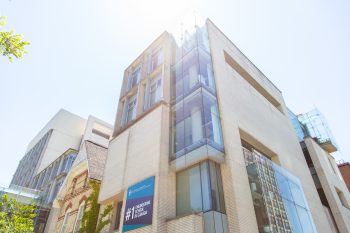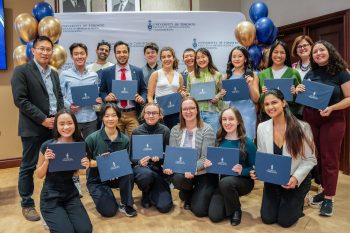Professor Kevin Golovin recently joined U of T’s Department of Mechanical & Industrial Engineering (MIE) as an Assistant Professor of Mechanical Engineering.
Golovin holds degrees in Material Science & Engineering from Cornell University (B.S.) and the University of Michigan (PhD). He leads the Durable Repellent Engineered Advanced Materials (DREAM) Laboratory and his research focuses on various types of repellent coatings. Golovin has collaborated extensively with industry, with partners including Boeing, Arc’teryx, lululemon, FPInnovations, Loop Recycled Products, and PRE Labs.
MIE writer Lynsey Mellon spoke to Golovin about his career and future plans.
What drew you to MIE at U of T?
I’m a coatings guy interested in how interfaces, meaning the intersection of two materials, can be designed.
MIE is home to many coatings experts. We’ve got the Centre for Advanced Coating Technologies (CACT), a one-of-a-kind coating fabrication facility, plus a handful of super smart people working tangentially to what my group focuses on.
When a position opened up in surface engineering I thought, “Hey, I engineer surfaces!” I even taught a course called Surface Engineering at UBC, where I worked at the time, so it felt like a natural fit.
Can you share a little about your research and what you like about it?
My group is the Durable Repellent Engineered Advanced Materials (DREAM) Laboratory, partly for the acronym, but also because that’s what we do.
We, the DREAM Team, engineer coatings that repel things — think of nonstick pans but apply the technology to many other sectors: airplane wings where ice and snow cannot adhere, boat hulls where barnacles and mussels don’t want to attach, oil pipelines where wax cannot deposit, etc. So that’s the ‘repellent’ part, but how those properties are added to a surface is no easy task, and that’s where the ‘engineered advanced materials’ bit comes in.
You may be familiar with things like Teflon being nonstick, but you may also be aware of the toxicity concerns around this entire class of materials, which is known as perfluoroalkylated substances (PFAS). Some of these were banned a few years ago and the remainder are being phased out soon. But PFAS were responsible for most repellent technologies in the past, which means we not only need to innovate improved performance to repel all these various liquid and solid substances, but we also need to do so in a sustainable and environmentally friendly way. A good part of what my group does is investigate new materials that can replace PFAS in a number of different sectors where they’re currently in use.
One of the biggest challenges in that space, or with coatings in general, is longevity. That’s where the ‘durable’ bit comes into play. Surface treatments need to last for them to find practical usage. Sometimes you can simply ask consumers to treat things lightly, such as not scrubbing a nonstick frying pan with an abrasive sponge, but you can see how the same advice would be impractical for a coating on an aircraft or a wind turbine blade. We need to keep in mind how to make coatings last and maintain their repellent properties for years and years.
Being able to potentially positively affect so many different industries with our coatings is a DREAM come true.
What are your goals, as both an educator and a researcher, over the next few years?
I’d like to see PFAS be completely replaced by our technology, or a related one, in the next few years. Industry has targeted the end of 2023, so that’s my goal as well.
PFAS are one of those things like hydrochlorofluorocarbons (HCFCs) that we’ll look back on and wonder why we were so lethargic about eliminating them. They can lead to birth defects, kill aquatic life, and cause certain cancers but they can still be found on dozens of items in your home right now and potentially on your body. That’s unbelievable to me and I want to change that as soon as possible.
Along with that, I want to train the next generation of engineers to think about innovation in the context of sustainability and human health. Humans had a good run innovating without regard to the planet and its inhabitants, but the next century has to be different if we want a diverse, equitable, and sustainable world for all. And that starts with education and getting the mindset of young budding engineers right. For young people my job is pretty easy in that regard – they know they’re in this world for the long haul and that our current trajectory isn’t going to cut it. So training them to be the solution-seekers of tomorrow is something I’m deeply passionate about.
What do you like to do in your spare time?
When I’m not “professoring” you can find me on the soccer pitch, on my bicycle, or hanging out with my partner, Alice. I love to kick, pedal, cook, and read — mostly anthropology, history and philosophy books.
Any advice for students starting with us in the fall?
To paraphrase a famous shoe brand, DO IT.
Join that club, email that prof, reach out to that group, make that connection. University goes by fast and what gets you through it are your peers and those you connect with along the way.
Don’t sit on the sidelines and don’t let anyone tell you that you’re not enough. Be your best self today and you’ll be happier for it tomorrow.



